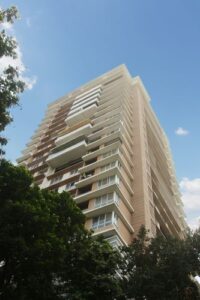Redefining Urban Living: The Rise of Mixed-Use Buildings

Mihir Kotak & Rinki Kotak
In the rapidly evolving landscape of modern cities, a revolutionary trend is taking shape — mixed-use buildings. These innovative structures seamlessly integrate residential, commercial, and recreational spaces, heralding a new era in urban living. As urban populations swell and land becomes scarcer, mixed-use developments offer a sustainable and efficient solution, transforming the way we live, work, and play.
Mixed-use buildings are not a novel concept. Ancient civilisations, such as Rome and Greece, combined various functionalities within single structures. Markets, residences, and public spaces coexisted harmoniously, fostering vibrant communities. However, the Industrial Revolution and subsequent urban planning paradigms created a segregation of functions, with distinct zones for housing, commerce, and industry.
The Resurgence of Mixed-Use Developments
Several factors drive the resurgence of mixed-use buildings in contemporary cities. Urbanisation, environmental concerns, and changing lifestyle preferences push architects and developers to rethink traditional cityscapes. By blending diverse functions, mixed-use buildings optimise land use, reduce the need for long commutes, and create dynamic, interconnected neighbourhoods.
One of the primary advantages of mixed-use developments is economic efficiency. These projects maximise land value and minimise infrastructure costs by concentrating multiple uses within a single area. Shared amenities such as parking, utilities, and public transportation hubs lead to cost savings for developers and residents alike.
Moreover, mixed-use buildings contribute to sustainability. Reduced reliance on automobiles decreases carbon emissions, while integrating green spaces, energy-efficient technologies, and sustainable materials further enhances environmental benefits. Walkable neighbourhoods promote healthier lifestyles, reducing the urban heat island effect and fostering a sense of community.
Mixed-use buildings significantly enhance the quality of urban life. Residents enjoy the convenience of having essential services, shops, and recreational facilities within walking distance. This proximity fosters a sense of belonging and encourages social interactions, vital for mental well-being. Furthermore, mixed-use developments often incorporate open spaces, parks, and cultural venues, enriching the urban experience.
The rise of mixed-use buildings has sparked a wave of architectural innovation. Designers are challenged to create spaces seamlessly blending different functions while maintaining aesthetic appeal and functionality. The result is a diverse array of visually striking structures that redefine skylines and set new standards for urban design.
Adaptive reuse is another trend gaining traction within mixed-use developments. Repurposing old factories, warehouses, and historical buildings into mixed-use spaces preserves cultural heritage while meeting contemporary needs. This approach conserves resources and adds character and uniqueness to urban environments.

Challenges and Considerations
Despite their numerous benefits, mixed-use developments present certain challenges. Coordinating various stakeholders, including residents, businesses, and local authorities, requires meticulous planning and effective communication. Zoning regulations and building codes must be carefully navigated to ensure the successful integration of diverse functions.
Additionally, balancing the needs and expectations of different user groups can be complex. To create harmonious living environments, noise, privacy, and security concerns must be addressed. Adequate infrastructure, such as public transportation and utilities, supports increased density and activity within mixed-use developments.
Closer to home, India is witnessing a surge in mixed-use developments. The rise of projects like Mumbai’s One BKC and Bengaluru’s Embassy One highlights the growing demand for integrated spaces that cater to diverse needs. These developments are redefining urban living by offering unparalleled convenience and lifestyle amenities.
As cities continue to grow and evolve, mixed-use buildings will play an increasingly vital role in shaping the future of urban living. The convergence of residential, commercial, and recreational spaces within single developments addresses the multifaceted demands of modern life. By fostering sustainable practices, enhancing quality of life, and promoting architectural innovation, mixed-use buildings are redefining the urban experience.
Mihir Kotak & Rinki Kotak, are Founders & Principal
Architects of 4th Dimension Mumbai.




